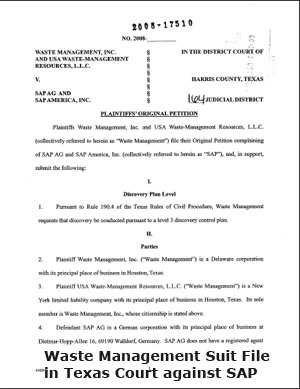The Demo Factor
 The lawsuit itself is interesting, and provides some valuable lessons for all companies in their evaluation and selection of supply chain software. The lawsuit itself is interesting, and provides some valuable lessons for all companies in their evaluation and selection of supply chain software.
The crux of the alleged “fraud” is that while SAP was positioning the solution as “proven,” and working with Waste Management’s team to vet the solution against the company’s business needs, it was, in fact, using a doctored version of the product in these evaluation stages that did not reflect the actual product to be installed. Interestingly, part of SAP’s sales team apparently included an ex-controller of Waste Management, hired by SAP to help it penetrate the US Waste and Recycling market.
The suit claims that “SAP presented Waste Management with a series of pre-contract product demonstrations consisting of what SAP represented was the actual waste and recycling software. Yet, Waste Management has discovered– and, in internal documents, SAP has admitted — that the pre-contract demonstrations were, in fact, nothing more than fake, mock-up simulations that did not use the software ultimately licensed to Waste Management. SAP’s senior executives... participated in these fake product demonstrations, which were rigged and manipulated.”
If true, this is far from the first time a software vendor has used this technique.
“While most supply chain software demos are above board, a sales team under pressure to win a deal where they don’t really meet functional requirements often has some tricks available to them,” said SCDigest editor Dan Gilmore. “One software vendor I knew in the past internally used to refer to which projects were “sold but not built,” meaning commitments or representations were made in the sales process that had to be delivered, but didn’t really yet exist.”
At the “screen” level of functionality, without real processing and integration behind it, it is relatively easy to make software look like it is doing something in demo mode that doesn’t reflect the huge effort it will take to actually fully develop that functionality in a working product.
What can companies do?
- Specifically ask what it is you are seeing: An entire software sales team may have trouble with a bold face lie that says the demoed version is what exists as real product today. But many prospects never really ask the question.
- Do Reference Calls/Site Visits that Ask the Tough Questions: If you can’t find another company using the functionality you need and that is promised, start to be wary. Even if a reference is using the functionality, ask the hard questions about whether it was custom-developed for them, or truly part of the base package.
Who Owns the ROI?
Another interesting aspect to the suit is that in addition to problems with the functionality and the inability to install the system, Waste Management is also alleging misrepresentations about project ROI.
The suit alleges that SAP helped Waste Management develop a business case that SAP “knew was defective... Based on SAP’s specific representations concerning the purported capabilities of its software, the Business Case generated net annual benefits to Waste Management of between $106 and $220 million per year,” the lawsuit claims.
A couple of things stand out. First, that’s a very broad range of expected ROI. Second, it begs the question of how strong a role a software vendor should play in developing the business case. Some are happy to play a strong and active role to help push sales through. Others are reluctant to do so because they believe there are too many factors that ultimately impact cost savings or other benefits.
The Waste Management case is unique in that it stemmed from what appears to be a total project failure, not a project disappointment. Nonetheless, buyers of any software would do well to study the suit to minimize their chances of surprises and problems after the sale.
What’s your take on the Waste Management-SAP lawsuit. How could either or both parties have acted differently to avoid this mess? What lessons are there in this case about buying software in general? Let us know your thoughts at the Feedback button below. |